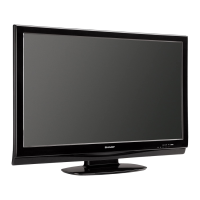
Do you have a question about the Sharp LC-37SB24U - 37" LCD TV and is the answer not in the manual?
States compliance with FCC rules and identifies the responsible party for the product in the USA.
Discusses FCC compliance, interference guidelines, and environmental considerations for disposal and recycling.
Lists trademarks associated with Dolby Laboratories, HDMI Licensing LLC, and ENERGY STAR certification.
Details safe procedures for moving the television, emphasizing the need for two people and careful handling.
Guides users through the process of safely attaching or detaching the TV stand, ensuring correct orientation and screw usage.
Provides instructions and warnings regarding wall mounting, recommending specific brackets and professional installation.
Offers step-by-step guidance for initial TV setup, including connecting the antenna, AC cord, and turning on the power.
Explains how to operate the TV using the remote control, including pointing it at the sensor and considerations for optimal performance.
Explains types of antenna connections (75-ohm coaxial, 300-ohm twin-lead) and how to connect them to the TV.
Details the procedure for inserting batteries into the remote control, including important cautions regarding battery types.
Labels the controls and indicators visible on the front panel of the television, such as power, sleep, and remote control sensors.
Identifies the input/output terminals and control buttons located on the top and rear panels of the television.
Provides a detailed breakdown of all buttons on the remote control unit and their corresponding functions for operating the TV.
Explains the necessary cables and connections for integrating audio/video equipment such as DVD players, VCRs, and game consoles.
Details the process of connecting a personal computer to the TV via RGB or HDMI cables for displaying PC content.
Explains how to turn the TV on and off using the power button on the unit or remote control, and the function of the power indicator.
Guides users through the first-time setup, including language selection, TV location, and automatic channel searching.
Details methods for changing TV channels using direct number input or channel up/down buttons.
Explains how to adjust the TV's volume level using the dedicated volume buttons on the remote control or unit.
Describes how to temporarily silence the TV's audio output using the MUTE button, with details on cancellation.
Allows users to set a timer for the TV to automatically switch to standby mode after a specified period.
Explains how to freeze the current video image on the screen, with notes on its availability and automatic cancellation.
Guides users on selecting different input sources (TV, HDMI, PC, etc.) to view content from connected external devices.
Allows selection of various picture modes (Standard, Movie, Game, Dynamic) to optimize image quality based on content.
Details options for adjusting audio settings, including MTS/SAP stereo modes and digital broadcasting audio formats.
Enables quick switching between the currently viewed channel and the previously tuned channel.
Explains how to enable and select closed caption services for viewing dialogue and narration as on-screen text.
Allows users to select different screen aspect ratios (e.g., Full Screen, Zoom, Stretch) to best fit the program content.
Explains the general procedure for navigating and operating the on-screen display menus using the remote control.
Details the specific functions of menu control buttons on the remote and main unit for interacting with the on-screen display.
Allows adjustment of picture settings like Backlight, Contrast, Color, Brightness, Tint, and Sharpness for optimal viewing quality.
Provides options to adjust sound quality, including Treble, Bass, Balance, Surround sound, and Bass Enhancer for better audio.
Enables energy-saving features like automatic shutdown when no signal is detected or no operation is performed.
Allows configuration of initial setup, channel memory, parental controls, language, and system resets for the TV.
Details the PC resolutions and frequencies compatible with the TV's input signals for optimal display performance.
Outlines software composition, copyright information, and how to obtain source code for open-source components.
